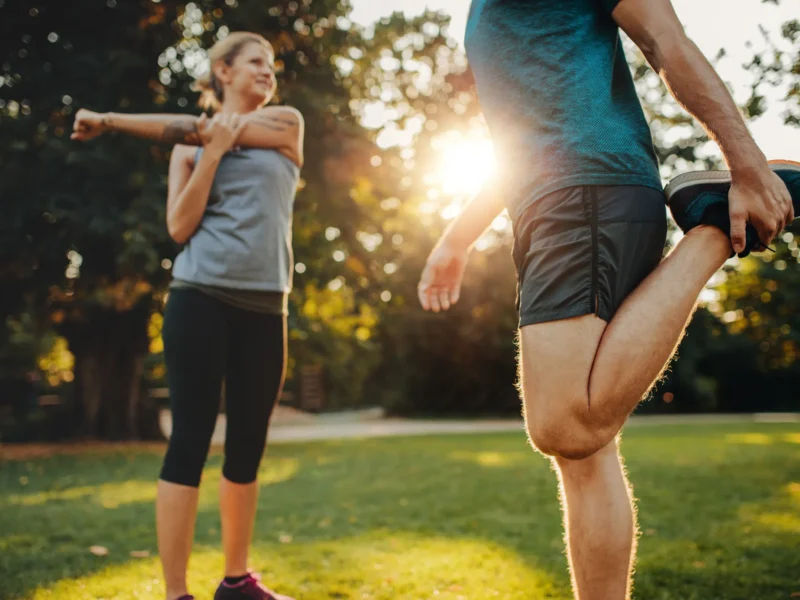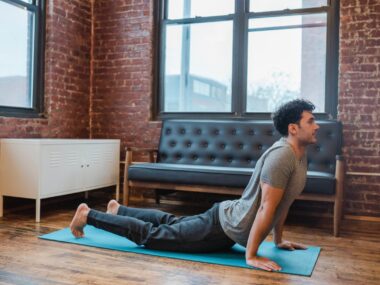Stretching is a fundamental component of any fitness routine, yet it’s often overlooked. Incorporating proper stretching techniques into your daily regimen can significantly enhance flexibility, reduce the risk of injury, and improve overall physical performance. This comprehensive guide covers the essentials of stretching, detailing best practices, types of stretches, benefits, and tips for integrating stretching into your lifestyle.

Understanding the Importance of Stretching
Enhancing Flexibility
Flexibility refers to the range of motion available to your joints. Improved flexibility allows for more efficient and safer movement patterns, reducing the risk of injuries. Stretching helps lengthen muscles and tendons, increasing the range of motion and making everyday activities easier and more comfortable.
Preventing Injury
Regular stretching can help prevent injuries by preparing muscles for physical activity. By increasing blood flow to muscles and improving flexibility, stretching ensures that your muscles are ready to perform, reducing the likelihood of strains and sprains. It also helps correct muscle imbalances that could lead to injuries.
Improving Posture
Poor posture is often a result of tight, shortened muscles. Stretching can help alleviate muscle tightness, promoting better alignment and posture. This is particularly important for individuals who spend long hours sitting or performing repetitive tasks.
Enhancing Performance
For athletes and fitness enthusiasts, stretching is crucial for optimal performance. Flexible muscles can generate more force and power, improving athletic performance. Stretching also helps reduce muscle fatigue and soreness, allowing for quicker recovery and better training consistency.
Types of Stretching
There are several types of stretching, each serving different purposes and best suited for specific times in your routine.
Static Stretching
Static stretching involves holding a stretch in a comfortable position for a period, usually between 15 to 60 seconds. This type of stretching is effective for increasing flexibility and is best performed after a workout when muscles are warm.
Examples:
- Hamstring Stretch: Sit with one leg extended and the other bent, reaching for the toes of the extended leg.
- Quadriceps Stretch: Stand on one leg, pulling the other foot towards your buttocks.
- Shoulder Stretch: Bring one arm across your body and use the other arm to press it closer to your chest.
Dynamic Stretching
Dynamic stretching involves moving parts of your body through
a full range of motion in a controlled manner. This type of stretching is ideal for warming up before physical activity, as it increases blood flow and prepares muscles for exercise.
Examples:
- Leg Swings: Swing one leg forward and backward or side to side while maintaining balance.
- Arm Circles: Extend your arms and make circular motions, gradually increasing the size of the circles.
- Lunge with a Twist: Step into a lunge position and twist your torso towards the leg that is in front.
Ballistic Stretching
Ballistic stretching uses the momentum of a moving body or limb to force it beyond its normal range of motion. This type of stretching can be risky as it may lead to muscle strains or injuries and is generally not recommended for the average person. It’s typically used by athletes under specific conditions.
Examples:
- Bouncing Toe Touches: Bouncing towards your toes to increase the stretch in your hamstrings.
- Bounding Lunges: Performing lunges with an exaggerated movement and a bounce.
Proprioceptive Neuromuscular Facilitation (PNF)
PNF stretching involves both stretching and contracting the muscle group being targeted. It is often done with a partner and is highly effective in increasing flexibility and range of motion. The process typically involves holding a stretch, contracting the muscle against resistance, then stretching it further.
Example:
- Hamstring PNF Stretch: Lie on your back with one leg extended. Your partner lifts the extended leg until a stretch is felt, you then push against the resistance for a few seconds, and upon relaxing, your partner increases the stretch.
Active Stretching
Active stretching involves holding a stretch using the strength of your agonist muscles. This type of stretching improves flexibility and muscle strength simultaneously.
Examples:
- Active Standing Quad Stretch: Stand on one leg and actively pull the other leg up behind you without using your hand.
- Active Seated Hamstring Stretch: Sit with one leg extended and actively reach for your toes using your core and hip flexor muscles.
Passive Stretching
Passive stretching is similar to static stretching but involves using an external force such as a partner, gravity, or a strap to help achieve the stretch. This type of stretching is useful for achieving a deeper stretch.
Examples:
- Partner-Assisted Hamstring Stretch: A partner helps to push your leg towards your torso while lying down.
- Using a Strap for Shoulder Stretch: Holding a strap behind your back to help pull your shoulder into a deeper stretch.
Best Practices for Stretching
Warm Up First
Always warm up your muscles before stretching to prevent injury. A proper warm-up increases blood flow to the muscles, making them more pliable and ready for stretching. Simple activities like brisk walking, jogging in place, or doing jumping jacks for 5-10 minutes can suffice.
Stretch Regularly
Consistency is key to improving flexibility. Aim to stretch at least 2-3 times a week, incorporating a variety of stretches targeting different muscle groups. For optimal results, daily stretching is recommended.
Hold Each Stretch Properly
When performing static stretches, hold each position for at least 15-30 seconds. Avoid bouncing or jerking movements, which can lead to muscle strains. Gradually deepen the stretch as you feel your muscles relax.
Breathe Deeply
Focus on deep, rhythmic breathing while stretching. Proper breathing helps relax your muscles and can improve the effectiveness of your stretch. Inhale deeply through your nose and exhale slowly through your mouth.
Listen to Your Body
Stretching should create a gentle pulling sensation, not pain. If you feel sharp pain, ease off the stretch immediately. Pushing too hard can cause muscle strains or injuries. It’s important to respect your body’s limits and progress gradually.
Balance Your Routine
Ensure that you stretch all major muscle groups and maintain balance between opposing muscle groups. For example, if you stretch your quadriceps, also stretch your hamstrings to avoid muscle imbalances that could lead to injury.
Incorporate Dynamic Stretches Before Exercise
Dynamic stretches are particularly beneficial before workouts as they mimic the movements you’ll be performing, increasing your range of motion and preparing your body for activity.
End with Static Stretches
Static stretches are best performed after exercise when your muscles are warm and pliable. This helps to enhance flexibility and reduce muscle stiffness after a workout.
Use Proper Technique
Focus on proper form to maximize the benefits of stretching and prevent injury. Ensure that your movements are controlled and deliberate. If you are unsure about your technique, consider consulting a fitness professional or using reputable online resources.
Benefits of Stretching
Increased Flexibility and Range of Motion
Regular stretching improves flexibility by lengthening the muscles and tendons, allowing your joints to move through their full range of motion. This increased flexibility can enhance performance in physical activities and reduce the risk of injuries.
Improved Posture
Stretching helps alleviate muscle imbalances and tightness that contribute to poor posture. By regularly stretching the muscles of the chest, shoulders, and lower back, you can improve your posture and alignment, reducing the strain on your muscles and joints.
Enhanced Blood Circulation
Stretching increases blood flow to your muscles, which can help improve circulation throughout the body. Enhanced circulation promotes the delivery of oxygen and nutrients to your muscles, aiding in recovery and reducing muscle soreness.
Reduced Muscle Tension and Stress
Stretching helps to relax and release tension in your muscles. This can be particularly beneficial after a long day of sitting or standing, helping to alleviate muscle tightness and stress. Incorporating stretching into your daily routine can also have a calming effect on your mind, reducing stress and promoting relaxation.
Injury Prevention
By increasing flexibility and range of motion, stretching can reduce the risk of injuries such as muscle strains and sprains. Stretching also helps to maintain muscle balance, preventing overuse injuries that can occur when certain muscle groups are stronger or tighter than others.
Enhanced Athletic Performance
For athletes, stretching is crucial for optimal performance. Flexible muscles can generate more force and power, improving athletic performance. Stretching also helps to improve coordination and balance, which are essential for many sports.
Sample Stretching Routine
Here is a sample stretching routine that targets all major muscle groups. This routine can be performed after a workout or as a standalone stretching session.
Neck Stretch
- Sit or stand with your back straight.
- Gently tilt your head to the right, bringing your ear towards your shoulder.
- Hold for 15-30 seconds, feeling the stretch along the left side of your neck.
- Repeat on the other side.
Shoulder Stretch
- Bring your right arm across your body at chest level.
- Use your left hand to gently press your right arm closer to your chest.
- Hold for 15-30 seconds, feeling the stretch in your shoulder.
- Repeat on the other side.
Triceps Stretch
- Raise your right arm overhead and bend your elbow, reaching your hand down your back.
- Use your left hand to gently push your right elbow further down.
- Hold for 15-30 seconds, feeling the stretch in your triceps.
- Repeat on the other side.
Chest Stretch
- Stand with your feet shoulder-width apart.
- Clasp your hands behind your back and straighten your arms.
- Lift your hands slightly while pulling your shoulders back.
- Hold for 15-30 seconds, feeling the stretch in your chest.
Upper Back Stretch
- Extend your arms in front of you at shoulder height.
- Clasp your hands together and round your back, reaching forward.
- Hold for 15-30 seconds, feeling the stretch between your shoulder blades.
Lower Back Stretch
- Lie on your back with your knees bent and feet flat on the floor.
- Hug your knees to your chest, gently rocking side to side.
- Hold for 15-30 seconds, feeling the stretch in your lower back.
Hip Flexor Stretch
- Kneel on your right knee with your left foot in front, forming a 90-degree angle.
- Shift your weight forward until you feel a stretch in your right hip.
- Hold for 15-30 seconds.
- Repeat on the other side.
Quadriceps Stretch
- Stand on your left leg, using a wall or chair for balance if needed.
- Bend your right knee and grab your right ankle, pulling it towards your buttocks.
- Hold for 15-30 seconds, feeling the stretch in your quadriceps.
- Repeat on the other side.
Hamstring Stretch
- Sit on the floor with your right leg extended and your left leg bent, with the sole of your left foot against your right inner thigh.
- Reach for your right toes, keeping your back straight.
- Hold for 15-30 seconds, feeling the stretch in your hamstring.
- Repeat on the other side.
Calf Stretch
- Stand facing a wall, with your hands pressing against it at shoulder height.
- Step your right foot back and press your heel into the floor.
- Hold for 15-30 seconds, feeling the stretch in your calf.
- Repeat on the other side.
Conclusion
Stretching is a vital aspect of maintaining and improving flexibility, preventing injuries, and enhancing overall physical performance. By incorporating a variety of stretching techniques into your routine and following best practices, you can achieve greater flexibility and enjoy numerous health benefits. Remember to stretch regularly, listen to your body, and maintain proper form to make the most of your stretching routine. Whether you’re an athlete, a fitness enthusiast, or someone looking to improve their daily life, stretching is an essential tool for a healthier, more flexible body.










